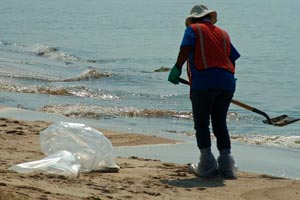The National Oceanic and Atmospheric Administration has been criticized this week for releasing a oil spill report on August 4 that has not been peer-reviewed and does not include the supporting data for their conclusions. In a conference call with reporters last night, the head of the agency defended their report (via Politico):
“We’re comfortable with our numbers and as we continue to learn more about what’s happening below the surface and elsewhere, we will build that into our estimate,” Jane Lubchenco, the chief of the National Oceanic and Atmospheric Administration, told reporters yesterday evening on a hastily-organized conference call.
“Given the heightened interest in the fate of the BP oil we felt it was appropriate to release that information as soon as possible,” she said.
Lubchenco called the criticism of the release “a tempest in a teapot” (via Huffington Post). “The report and the calculations that went into it were reviewed by independent scientists,” Lubchenco said. “And we are pulling together the full background information that would go into a more comprehensive report.” (I was not invited on this particular conference call.)
There are still plenty of questions surrounding the decision to release the report. NOAA scientist Bill Lehr said yesterday that the report was “estimate for response purposes” rather than a final report. But it was widely touted by administration officials and in the news media as a conclusive documentation of the fate of the oil in the Gulf. NOAA hosted a call with congressional staffers on Wednesday, and several listeners (including myself) got the impression that it was the National Indicent Commander (currently Thad Allen) and the White House who released the report to reporters and the public, despite the fact that it had not undergone thorough review.
Several other listeners on that call, and officials at the Department of Commerce, of which NOAA is a division, have denied that this was the case. Commerce spokesman Shannon Gilson said in a statement: “Dr. Lubchenco and the Incident Command decided to release the estimate to the American people given the heightened interest in the fate of the oil. Any speculation that Bill Lehr suggested otherwise on a call with Congressional staffers is false.”
Lehr did not take any questions from reporters yesterday following his testimony to a House subcommittee.
Regardless of who decided to release it, administration officials repeatedly gave the impression that the report had been thoroughly vetted before it was released. Lubchenco told reporters there was a “high degree of confidence” in the numbers. “The likelihood of large-scale changes is very, very small because we have so much certainty in some of the numbers,” she told reporters at a press conference the day the report was released. White House climate and energy adviser Carol Browner echoed that the report had “been subjected to a scientific protocol, which means you peer review, peer review and peer review.”
A number of independent scientific studies since then have raised questions about the government’s report. My main criticism, however, is not necessarily that the report is “wrong,” but that it’s impossible to check the math without access to the data, methodology, assumptions, and literature that went into drawing the conclusions released earlier this month. The government released conclusions about the fate of the oil, without the substantiating information. NOAA’s Lehr says they’re not releasing that information for another two months, possibly longer.
Special Report: Check out our in-depth investigation of BP’s crimes in the Gulf, “BP’s Deep Secrets.”
















